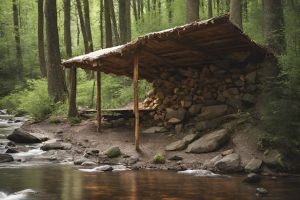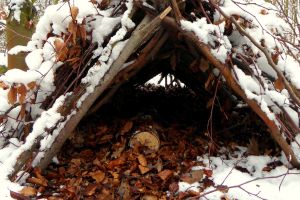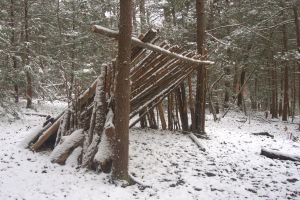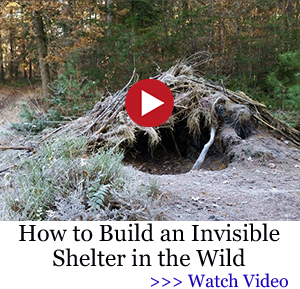Shelter Mistakes That Can Get You Killed

![]()
One of the most important wilderness survival skills to learn is how to build a shelter.
A fire may give you warmth and a means to cook food and purify water, but a shelter provides you with protection from the elements, such as rain, snow, sleet, or wind, each of which a fire can’t protect you against.
It’s also possible to build a shelter, however, that works against you and can actually harm you (if not kill you outright) if it’s improperly instructed.
We’re here to teach you how you can make sure this never happens.
Here are the top ten shelter mistakes that you should avoid at all costs:
Regardless of how well-constructed your shelter is, selecting the wrong shelter location can have dire consequences.

Avoid setting up camp in low-lying areas prone to flooding, near dead trees that could fall, or in areas with a high risk of rockslides or avalanches.
You’ll also want to avoid building your shelter on the side of a hill or mountain, where it can become easily vulnerable to strong winds.
There is so much more to choosing the right location for your shelter, and this guide has all the information you need, from how to utilize the terrain in your favor to how to choose the orientation of your shelter.
You can learn here everything you need to know if you want to be prepared for an event where they have no other choice but to live in the wild.
While it may seem convenient to set up camp near a water source, building too close to water can pose risks such as flash floods or attracting wildlife. Choose a location that is a safe distance from water while still being within walking distance.
Failing to account for weather conditions can leave you exposed to the elements. Always check the weather forecast before heading into the wilderness and prepare for changes in temperature, precipitation, and wind. If you are unable to check the forecast or if the forecast is incorrect, the only thing you can do on your part is to be prepared beforehand.
For example, you may convince yourself that you don’t need a tarp when going on a hike because the forecast shows it won’t rain. But if you find yourself stranded and it ends up raining anyway, that tarp could prove lifesaving as the roof or wall for your shelter to keep you shielded from getting wet.
 In cold environments, insulation is crucial for retaining body heat and preventing hypothermia. Avoid sleeping directly on the ground and use insulating materials such as leaves, or a sleeping pad to create a barrier between you and the cold.
In cold environments, insulation is crucial for retaining body heat and preventing hypothermia. Avoid sleeping directly on the ground and use insulating materials such as leaves, or a sleeping pad to create a barrier between you and the cold.
You should also place identical or similar materials in the wall of your shelter.
The size of your shelter should match your needs and the number of people in your group.
Building a shelter that is too large can be difficult to heat, while one that is too small may not provide enough space for you to sleep comfortably.
A good rule of thumb is to construct a shelter that is about a foot longer than your body length.
Poor ventilation in a shelter can lead to condensation buildup, which can make you wet and cold.
Ensure your shelter has adequate airflow by incorporating ventilation holes or leaving small gaps in the structure.
Selecting the wrong materials for your shelter can compromise its durability and effectiveness. Choose sturdy, weather-resistant materials such as tarps that can withstand the elements.
The flimsy space blankets that you can get for cheap at most sporting goods stores may offer a little degree of protection, but they also can rip and tear easily and won’t offer much strength or protection against strong winds.
 Failing to secure your shelter properly can leave you vulnerable to collapse in high winds or heavy rain.
Failing to secure your shelter properly can leave you vulnerable to collapse in high winds or heavy rain.
Use sturdy anchors such as rocks or stakes to secure your shelter and regularly inspect it for damage or wear.
Related: Emergency Shelters When You Are on the Move
If you build a lean-to shelter, make sure that the poles are tightly lashed together and to the trees; the last thing you’ll want is for your shelter to collapse over you in the middle of the night while you’re sleeping.
While it may be tempting to construct an elaborate shelter, simplicity is often best in wilderness survival situations. Avoid building overly complex structures that require extensive time and resources to construct.
A simple lean-to shelter that faces the direction of the wind to protect you from it can often be all that is needed to get you through the night. A shelter that’s longer and more complex could take up too much time and precious energy to construct.
Fire can provide warmth and comfort in the wilderness, but failing to follow proper fire safety protocols can be dangerous. That’s why you need to be very careful about building a fire around your shelter. It’s possible if your fire is too close, for instance, for the leaves and wooden poles that make up your shelter to catch fire from the flames.
The good news is your fires can be obtained in designated fire rings or pits. Collect rocks to build a perimeter around your fire and then dig a little into the ground to make a pit, and this will go a long way to ensuring that your pit is contained properly. Additionally, never leave fires unattended, and ALWAYS fully extinguish them before leaving your campsite.
A good strategy with shelter building is to take a weekend and practice building a shelter in the woods. Do this more than once so you get the hang of shelter building from personal experience, and while making you avoid each of the above mistakes we’ve covered today.
You never want a true survival scenario to be the first time you construct a shelter. When venturing into the wilderness, having the skills to build a shelter can literally be a matter of life or death.
You may also like:
 Food-Stretching Tips From The Great Depression
Food-Stretching Tips From The Great Depression
If You See This Plant in Your Backyard, Don’t Step on It (Video)
Top 10 Vehicles For Your EMP Survival
Stop Throwing Away Spoiled Milk! Do This Instead
How To Build Self-Watering Raised Garden Beds
